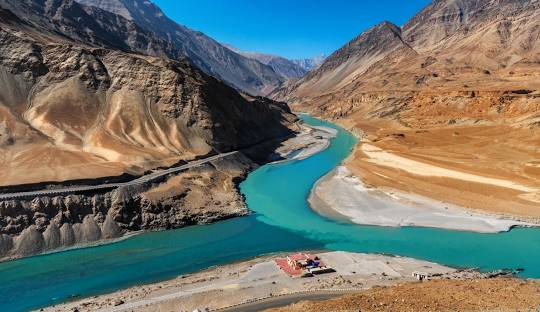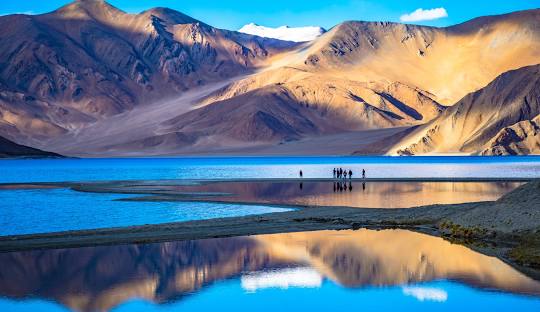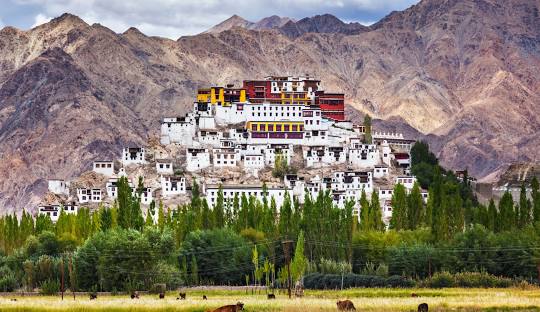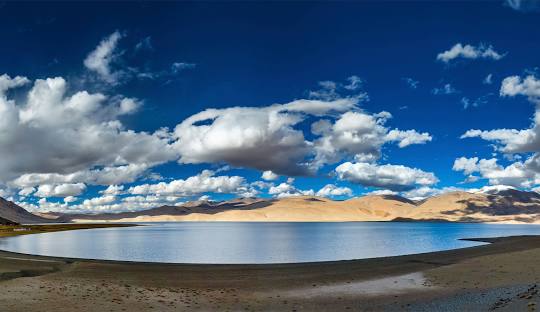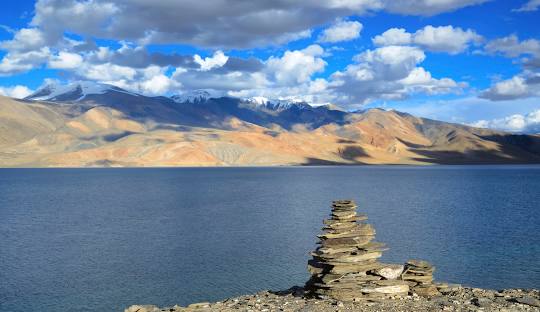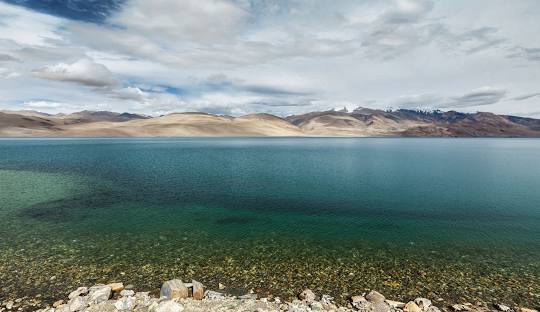- LEH : was the capital of the Himalayan kingdom of Ladakh, now the Leh District in the state of Jammu and Kashmir, India. Leh, with an area of 45,110 km2, is the second largest district in the country (after Kutch, Gujarat) in terms of area. The town is still dominated by the now ruined Leh Palace, former mansion of the royal family of Ladakh, built in the same style and about the same time as the Potala Palace. Leh is at an altitude of 3524 meters (11,562 ft) , and connects via National Highway 1D connects it to Srinagar in the southwest and to Manali in the south via Leh-Manali Highway
- PANGONG TSO : is an endorheic lake in the Himalayas situated at a height of about 4,350 m (14,270 ft). It is 134 km (83 mi) long and extends from India to Tibet. 60% of the length of the lake lies in China. The lake is 5 km (3.1 mi) wide at its broadest point. During winter the lake freezes completely, despite being saline water. The lake is in the process of being identified under the Ramsar Convention as a wetland of international importance. This will be the first trans-boundary wetland in South Asia under the convention
- KAHRDUNGLA PASS: Khardung La (elevation 5600m) is a high mountain pass located in the Ladakh region. The local pronunciation is "Khardong La" or "Khardzong La," but, as with most names in Ladakh, the romanised spelling varies. The pass on the Ladakh Range lies north of Leh and is the gateway to the Shyok and Nubra valleys. The Siachen Glacier lies partway up the latter valley. Built in 1976, it was opened to motor vehicles in 1988 and has since seen many automobile, motorbike and mountain biking expeditions. Maintained by the Border Roads Organisation, the pass is strategically important to India as it is used to carry supplies to the Siachen Glacier. Khardong La is historically important as it lies on the major caravan route from Leh to Kashgar in Chinese Central Asia. About 10,000 horses and camels used to take the route annually, and a small population of Bactrian camels can still be seen at Hundar, in the area north of the pass. During World War II there was an attempt to transfer war material to China through this route.
- HEMIS : is a town in India 40 km southeast of Leh in Ladakh, well known for the Hemis monastery that was established in 1672 AD by King Senge Nampar Gyalva. Hemis is best known to tourists for the colorful festival held in July. Hemis also could be associated with the Hemis National Park, an area that is home to the endangered snow leopard. The national park was created in 1981. It is the only high altitude park in the country.
Waves of Ladakh
Leh - 4 Nts, Pangong Lake - 1 Nts
Waves of Ladakh 5 Nts / 6 Days
Leh - 4 Nts, Pangong Lake - 1 Nts
 Hotels |
 Sightseeing |
 Meals |
Leh Airport
01 December 25
| Adult | 0 | X | 0 | 0 |
|---|---|---|---|---|
| Extra Adult | 0 | X | 0 | 0 |
| Child | 0 | X | 0 | 0 |
| GST @ 5% on Rs 0.00 | 0 | |||
| Total | 0.00 | |||
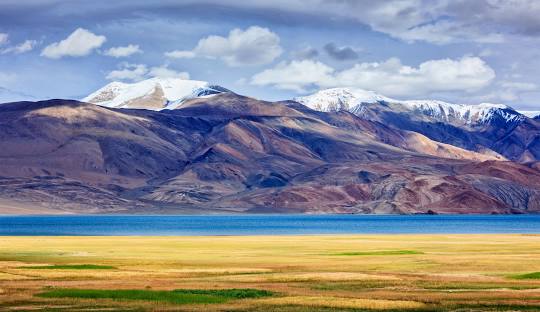
Arrive from Leh airport our representative will meet you and transfer you to Hotel. Check in to the hotel. Complete rest for the day after welcome tea and coffee in Hotel, walk around Leh town includes a visit to Leh Market, Leh Palace or Shankar monastery; in the evening return back to Hotel for overnight stay.
Day excursion to Khardongla pass which is the highest motorable pass in the world 5600 Mtrs and has been recorded in the Guineas Book of world Records, at the top enjoy the beauty of snow capped mountains. In the late afternoon return back to the Hotel, Overnight at hotel.
After breakfast drive for full day sight seeing of Shey Palace, Thiksey, Hemis monastery & Stok Palace Museum. In the evening drive back to Hotel for overnight stay.
After early breakfast we drive to Pangong Tso Lake. From Leh we reach Karu, an Army camp on Leh-Manali road and then turn left and cross Changla Pass (17500 ft) and finally to Tangtse. Evening at leisure, overnight stay little beyond Tangtse in Camped camp at Lukung near Pangong lakeshores.
Pangong Lake, is a long narrow basin of inland drainage, about 1/3rd of the lake is under Indian occupation and remaining under China. The Chinese border is just beyond the mountains across the lake. Spangmik, 7 km along the southern shore from the head of the lake is the farthest point to which foreigners are permitted. There are spectacular views of the mountains of Changchenmo range to the north and their shimmering reflection in the ever-changing blues and greens of the lake’s brackish waters is breathtaking. Above Spangmik are the glaciers and snow-capped peaks of the Pangong range. Spangmik and other scattered tiny villages along the lake’s southern shore are the summer homes of a scanty population of Chang-pa, the semi-nomadic herdsmen of Tibet and southeast Ladakh. The Pangong Chang-pa cultivate sparse crops of barely and peas in summers. During the winters that they pack their Camps (rebo) and take their flocks of sheep and Pashmina goats out to the distant pastures. Overnight stay little beyond Tangtse in Camped camp at Lukung near Pangong lakeshores.
After Breakfast leave from Pangong Lake and drive back to Leh at same route and walk around Leh town includes a visit to Leh Market, in the evening return back to Hotel for overnight stay.
Transfer in time to the airport to connect onward destination flight
- Accommodation on Double share basis.
- Breakfast & Dinner as mentioned in the itinerary.
- All transfer and sightseeing by NON AC Ertiga / Xylo/ Innova.
- All Toll tax, Parking & Driver Bata.
- All entrance fees & Inner Line Permission
- Alcoholic, Soft drinks, Laundry and tips.
- Any expenses not mentioned in the Include column.
sfds
sdffs
svfd











